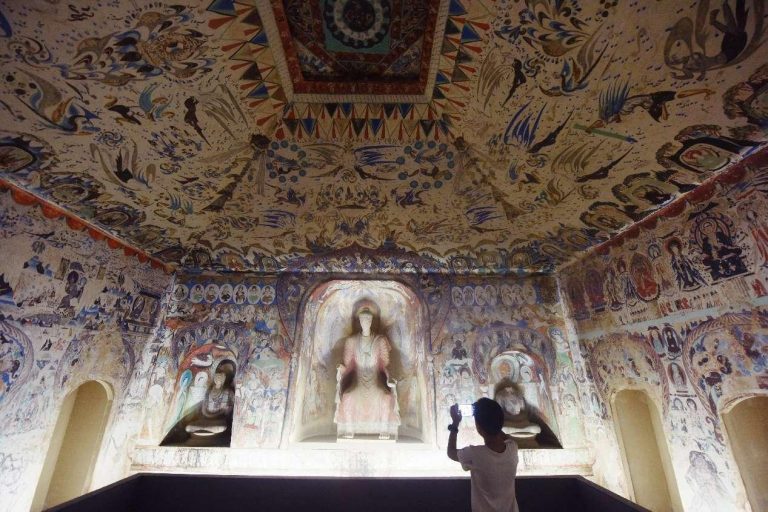
Represented by the Buddhist art of the Mogao Grottoes and cultural relics from the Library Cave, Dunhuang culture has spanned nearly 2,000 years. It is a crystallization of the integration and convergence of Chinese culture with foreign cultures such as Indian, Greek, and Persian, and a shining pearl in the long river of world civilizations.
The Dunhuang Grottoes boast rich historical, cultural, and artistic value, and after thousands of years, the murals there are facing the danger of degradation. How can we permanently preserve the information of the Dunhuang Grottoes?
In the late 1980s, Fan Jinshi, then executive deputy dean of the Dunhuang Academy, first proposed the concept of “digital Dunhuang,” which aimed at using digital technology to permanently and faithfully preserve murals and colored sculptures.
Over the past 30 years, the professional digitalization team at the Dunhuang Academy has actively collaborated with domestic and international research institutions, gradually establishing an accurate, authentic, and high-definition “digital Dunhuang” database. This database provides crucial support for the preservation of the Dunhuang Grottoes, the studies of Dunhuangology, and the promotion of Dunhuang culture.
Today, the once-immovable grotto relics have taken flight with the wings of digital technology, reaching destinations all around the world.
In 2022, the world’s first blockchain-based digital resource-sharing platform went online. Through the use of artificial intelligence technology, the platform collects elements from murals in the Dunhuang Grottoes, making available more than 6,500 archived high-definition digital images showing murals and manuscripts from the Mogao Grottoes and other grotto sites in Dunhuang. These resources are now open to the world in 19 thematic categories.
Thanks to the continuous efforts to improve the preservation of cultural relics and outreach approaches, the gap between the Dunhuang cultural heritage and the general public has been significantly narrowed. In 2022 alone, the Dunhuang Academy has garnered over 200 million views on media platforms, with visitors from 120 countries and regions.
In the past decade since the Belt and Road Initiative (BRI) was proposed, the Dunhuang Academy has carried out a series of international academic and cultural exchange activities.
In 2018, it sent a delegation to Afghanistan for an academic survey. After learning in detail the difficulties faced by and demands of Afghanistan’s Bamyan Province in cultural heritage research, protection and education, the delegation provided targeted recommendations and discussed future areas and methods for strengthening cooperation, in an attempt to jointly safeguard and promote the historical and cultural heritage of the Silk Road.
The BRI creates new opportunities for the development of Dunhuang culture, and the Dunhuang culture in turn provides cultural support for advancing Belt and Road cooperation.
Over the past 10 years, experts with the Dunhuang Academy have visited Iran, Afghanistan, Uzbekistan, Kyrgyzstan, and other countries many times for investigations and exchanges on ancient Silk Road sites.
In 2017, at the invitation of the Kyrgyz side, the National Cultural Heritage Administration of China assigned the Dunhuang Academy to conduct feasibility research on a protection and restoration project of ancient castle ruins in Kochkor District, Naryn Region, Kyrgyzstan.
Based on a comprehensive investigation and study of these ruins, engineering projects were carried out for cultural relics protection, digital preservation, preventive heritage protection, and site display, laying a solid foundation for China’s cooperation with more countries in the field of cultural heritage.
As we gradually carried out investigations at ancient sites in Silk Road countries, we discovered that though these countries’ cultural relics were made from different materials and with different techniques, there has been a very close cultural connection among these sites.
The cultural heritage protection technology system of the Dunhuang Academy not only has contributed to over 200 key national cultural relics protection projects in China but also plays a positive role in the protection of cultural relics and sites in other Silk Road-related countries.
This year, we have undertaken an international aid project that aims to digitally document the murals on the west door arch wall on the first floor of the Thatbyinnyu Temple in Bagan, Myanmar, as well as the ruins of the temple’s north gate.
Going forward, we will continue to cooperate with other countries and contribute to the protection and research of Silk Road cultural heritage.










